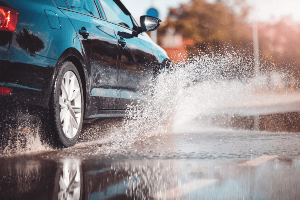 Wisconsin has a 10-month-long rainy season. Our state experiences the most rain in the summer, averaging about four inches between June and August. With so much rain, there is an increased chance of getting into a hydroplaning accident.
Wisconsin has a 10-month-long rainy season. Our state experiences the most rain in the summer, averaging about four inches between June and August. With so much rain, there is an increased chance of getting into a hydroplaning accident.
If you were injured in a hydroplaning accident, you may be wondering who could be held liable for your damages. The answer comes down to who acted negligently. Our Oshkosh car accident attorneys are prepared to thoroughly investigate the accident to determine who should pay the cost of your damages.
We offer a free consultation to determine what legal options may be available to you. If we validate your case, we do not charge you anything while we work with you. You only pay us when we recover compensation for you.
What is Hydroplaning?
Hydroplaning occurs when a vehicle’s tires lose traction due to too much water getting between the tire treads and the roadway. This can cause a driver to lose control of his or her vehicle, possibly resulting in a spin out.
Vehicles with two-wheel drive may be more at risk for hydroplaning, as there are fewer wheels to maintain a grip on a wet road. Due to heavy snow in the state, though, many drivers have vehicles with four-wheel drive or all-wheel drive.
Drivers whose vehicles begin to hydroplane may feel a sudden jerk as if their vehicle is floating or veering on its own. Hydroplaning could occur for just a moment or for longer, depending on how much water is on the road.
What Factors Contribute to Hydroplaning?
There are several factors that contribute to hydroplaning.
The first factor is speed. The faster a vehicle is traveling the more likely it is to hydroplane due to large amounts of water on the road. Generally, a vehicle is more likely to hydroplane while traveling over 45 mph.
Tire tread is another factor that will likely contribute to hydroplaning. If a vehicle has worn tires, it will lose traction more quickly than a vehicle with good tire tread. Underinflated tires may also have more difficulty maintaining traction on the road.
The depth of the water a vehicle is driving over also matters. If a vehicle drives over a shallow puddle, even at high speeds, there is a smaller chance of hydroplaning. However, a vehicle traveling at the average roadway speed limit of about 45 mph over a deep enough puddle has a significantly increased chance of hydroplaning.
While driving in heavy rain, or shortly after a heavy rainstorm, it is best to keep a safe following distance, slow down and focus on the road with both hands on the steering wheel. You should also keep an eye on how others are driving to avoid vehicles traveling at an unsafe speed.
How is Liability Determined for a Hydroplaning Accident?
Liability for a hydroplaning accident comes down to whose negligent actions resulted in an accident that injured you. Generally, fault for these crashes will fall on another driver if he or she was engaged in some form of reckless or negligent driving, such as:
- Speeding
- Driving too closely
- Distracted
A driver whose worn tires caused his or her vehicle to hydroplane and then crash into yours may also be liable because of poor vehicle maintenance. This is because drivers have a legal duty to keep their vehicles in safe operating condition, including ensuring their tire tread is not overworn or their tires are not underinflated.
While the driver of the vehicle that hydroplaned is usually at fault for a hydroplaning collision, there are some other parties who may be held liable:
- Vehicle owners – Sometimes drivers borrow vehicles from friends and family, or a parent owns the vehicle their child is driving. In these cases, the owner of the vehicle could be held liable for your damages caused by the driver borrowing the car. This is heavily fact dependent.
- Employers – If an employee causes a hydroplaning accident while on company time or in a company-owned vehicle, his or her employer could be held liable for your damages.
In some rare instances, a mechanic may be liable for a hydroplaning accident if he or she failed to change (or offer to change) worn tires.
To hold a party responsible, your attorney must be able to prove there was a negligent action that caused the crash and the injuries you suffered were a direct result of that negligence.
What Should I Do After a Hydroplaning Accident?
If you were involved in a hydroplaning accident, the first thing you need to do is call 9-1-1. This will send the police to conduct a preliminary investigation and get you the medical attention you need at the scene. Even if you do not think you are seriously hurt, it is a good idea to get a proper medical evaluation at the scene of the crash to determine if you need further medical treatment at the hospital.
While waiting for the police and ambulance to arrive, and if it is safe to do so, you should take photos of the damage to the vehicles involved in the crash. If you suspect hydroplaning, take photos of the weather conditions as well as what the road looks like. Is there a lot of water on the ground? Are there large puddles? Were those puddles easily avoided?
Next, you should get in contact with an attorney.
Call an Experienced Attorney Today
Our lawyers have decades of experience helping accident victims recover compensation for their medical bills, lost wages and other damages. We do not charge you anything up front or while we work on your case.
The consultation is also free and confidential. There is no risk to you.
Call (877) 888-5201 today to get started.